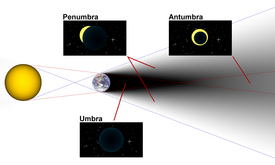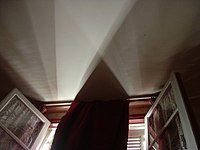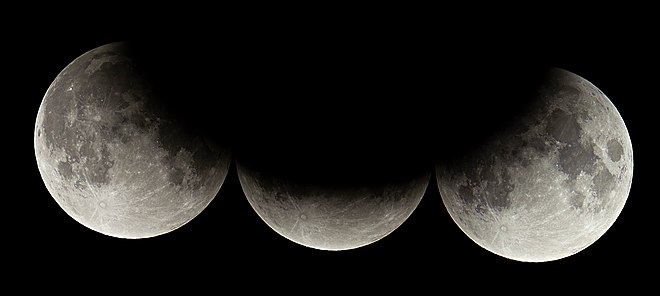Umbra, penumbra and antumbra
This articleneeds additional citations forverification.(December 2012) |


Theumbra,penumbraandantumbraare three distinct parts of ashadow,created by any light source after impinging on anopaqueobject. Assuming nodiffraction,for acollimated beam(such as a point source) of light, only the umbra is cast.
These names are most often used for the shadows cast bycelestial bodies,though they are sometimes used to describe levels, such as insunspots.
Umbra[edit]

Theumbra(Latin for "shadow" ) is the innermost and darkest part of a shadow, where the light source is completely blocked by the occluding body. An observer within the umbra experiences a totaloccultation.The umbra of a round body occluding a round light source forms aright circular cone.When viewed from the cone'sapex,the two bodiesappear the same size.
Thedistancefrom theMoonto the apex of its umbra is roughly equal to that between the Moon andEarth:384,402 km (238,856 mi). SinceEarth's diameteris 3.7 times the Moon's, its umbra extends correspondingly farther: roughly 1.4 million km (870,000 mi).[1]
Penumbra[edit]
Thepenumbra(from the Latinpaene"almost, nearly" andumbra"shadow" ) is the region in which only a portion of the light source is obscured by the occluding body. An observer in the penumbra experiences apartial eclipse. An alternative definition is that the penumbra is the region wheresome or allof the light source is obscured (i.e., the umbra is a subset of the penumbra). For example,NASA'sNavigation and Ancillary Information Facilitydefines that a body in the umbra is also within the penumbra.[2]


Antumbra[edit]

Theantumbra(from the Latinante"before" andumbra"shadow" ) is the region from which the occluding body appears entirely within the disc of the light source. An observer in this region experiences anannular eclipse,in which a bright ring is visible around the eclipsing body. If the observer moves closer to the light source, the apparent size of the occluding body increases until it causes a full umbra.[3]
See also[edit]
References[edit]
- ^Pogge, Richard."Lecture 9: Eclipses of the Sun & Moon".Astronomy 161: An Introduction to Solar System Astronomy.Ohio State University.RetrievedJuly 16,2015.
- ^Event Finding Subsystem PreviewNavigation and Ancillary Information Facility.
- ^"Eclipses: What Is the Antumbra?".timeanddate.com.Retrieved26 May2019.
